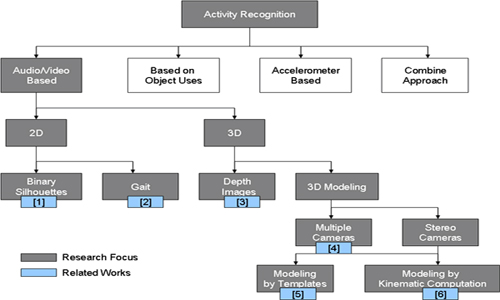Research summary of Jehad Sarkar
| |
|
| Motivation |
Develop and Implement an efficient system that can perform Human Activity Recognition using stereo data rather than using binary 2D silhouettes as ordinary ways. |
| Methodology |
- Stereo Computation: From pair of pictures of left and right cameras, compute the disparity between pixels by pixels, and then estimate distance between cameras and objects, present depth on gray scale images.
- Background Removal: Model and Remove background
- Estimate Depth Silhouettes: Extract interesting depth silhouettes, normalize the size and then rectify with binary silhouettes.
- Spatial Inference: Fit the 3D articulated skeleton with human body by NBP( Nonparametric Belief Propagation)
- Temporal Inference: From a sequence of 3D skeleton of human body, use Hidden Markov Model( HMM) to learn and then retrieve activity
|
| Work flow |
|
| Research Taxonomy |
 |
| References |
- Liang et al.2003. Silhouette analysis-based gait recognition for human identification. IEEE PAMI. v25. 1505- 1518
- Kale et al., 2004. Identification of humans using gait. IEEE Transactions on Image Processing. v13. 1163-1173
- Rafael et al., 2008 Depth silhouettes for gesture recognition , Pattern Recognition Letters. v29. 319-329
- Radu et al. 2008. Human motion tracking by registering an articulated surface to 3-D points and normals, IEEE PAMI (Accepted)
- Hee-Deok et al. 2007. Reconstruction of 3D human body pose from stereo image sequences based on top-down learning , Pattern Recognition. v40 3120 – 3131
- David et al. 2007. Human motion tracking with a kinematic parameterization of external contours. Journal of Computer Vision.
|
|
|
| :: UC Lab News |
06-24-2008
New website launched by Activity Recognition team...
|
|

